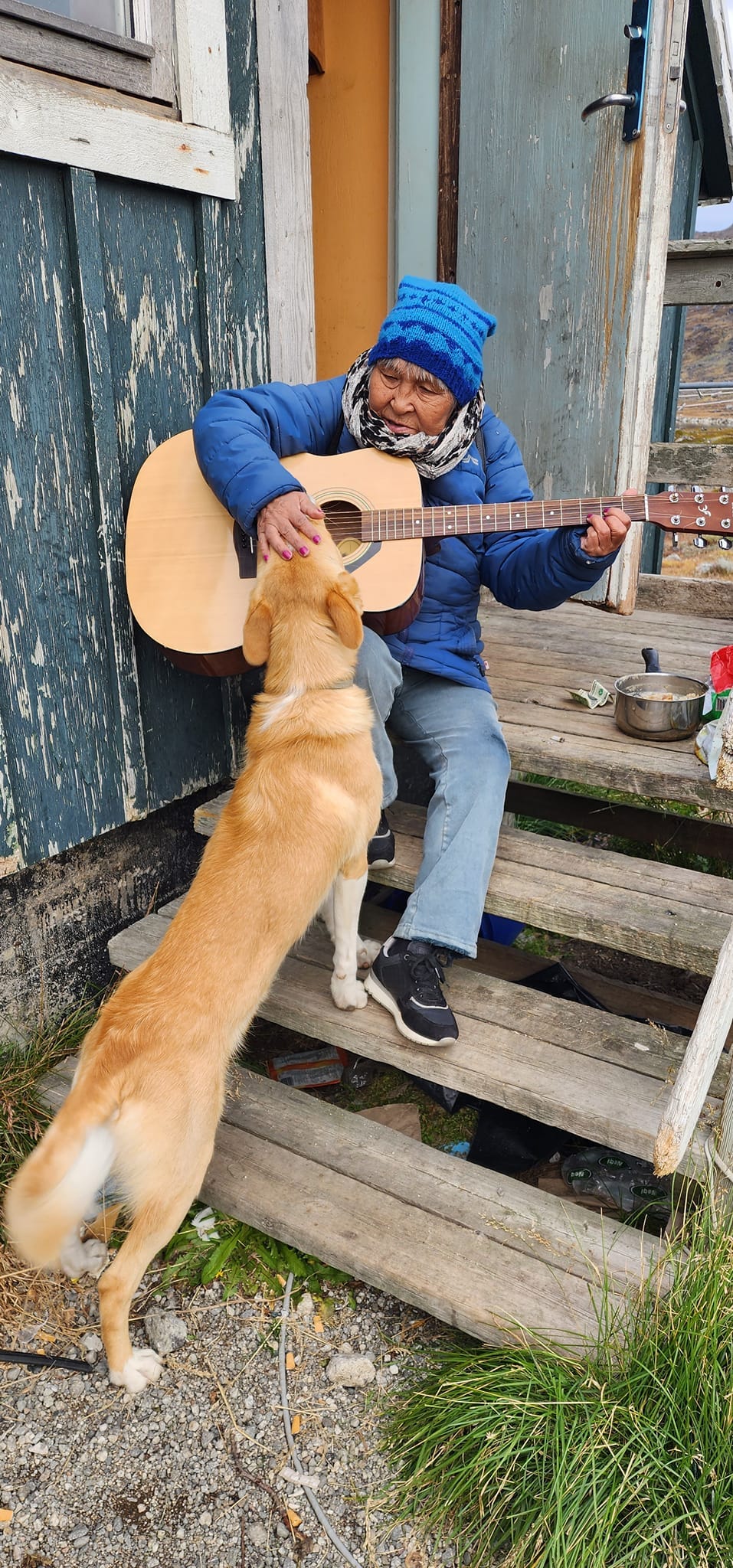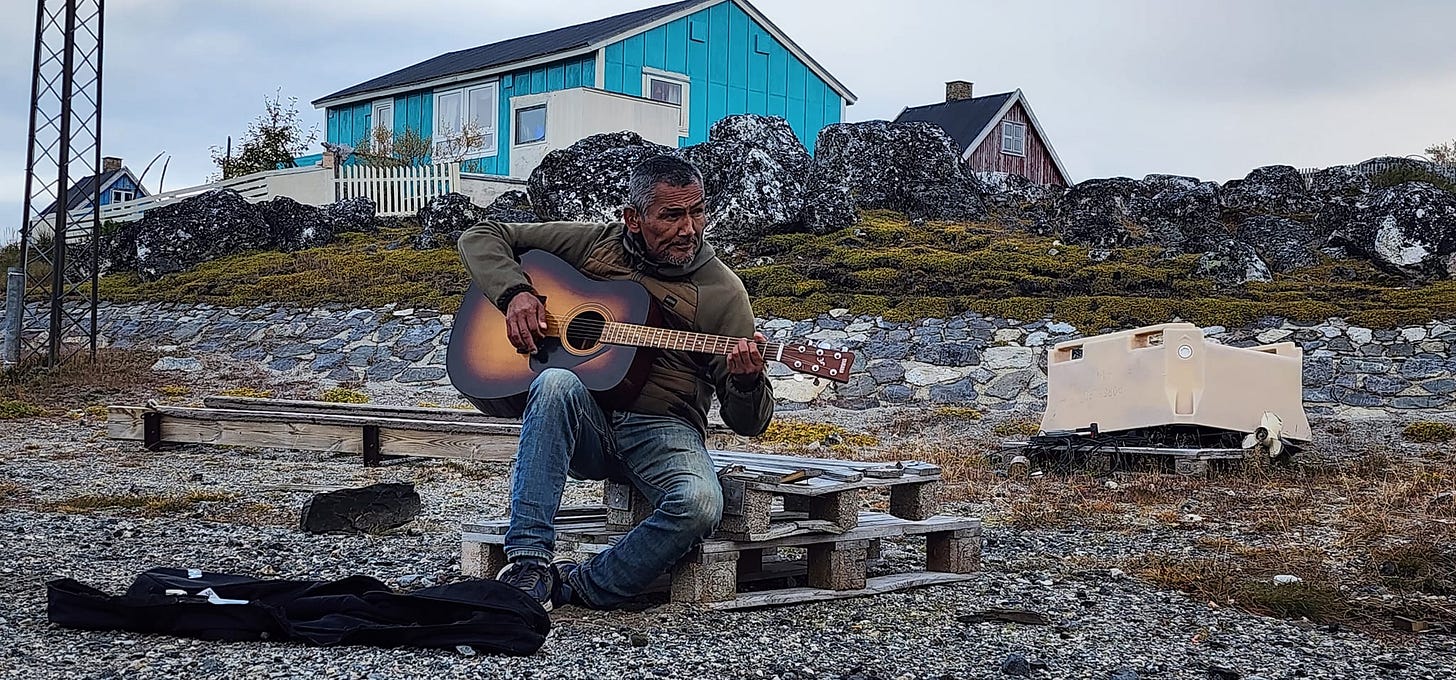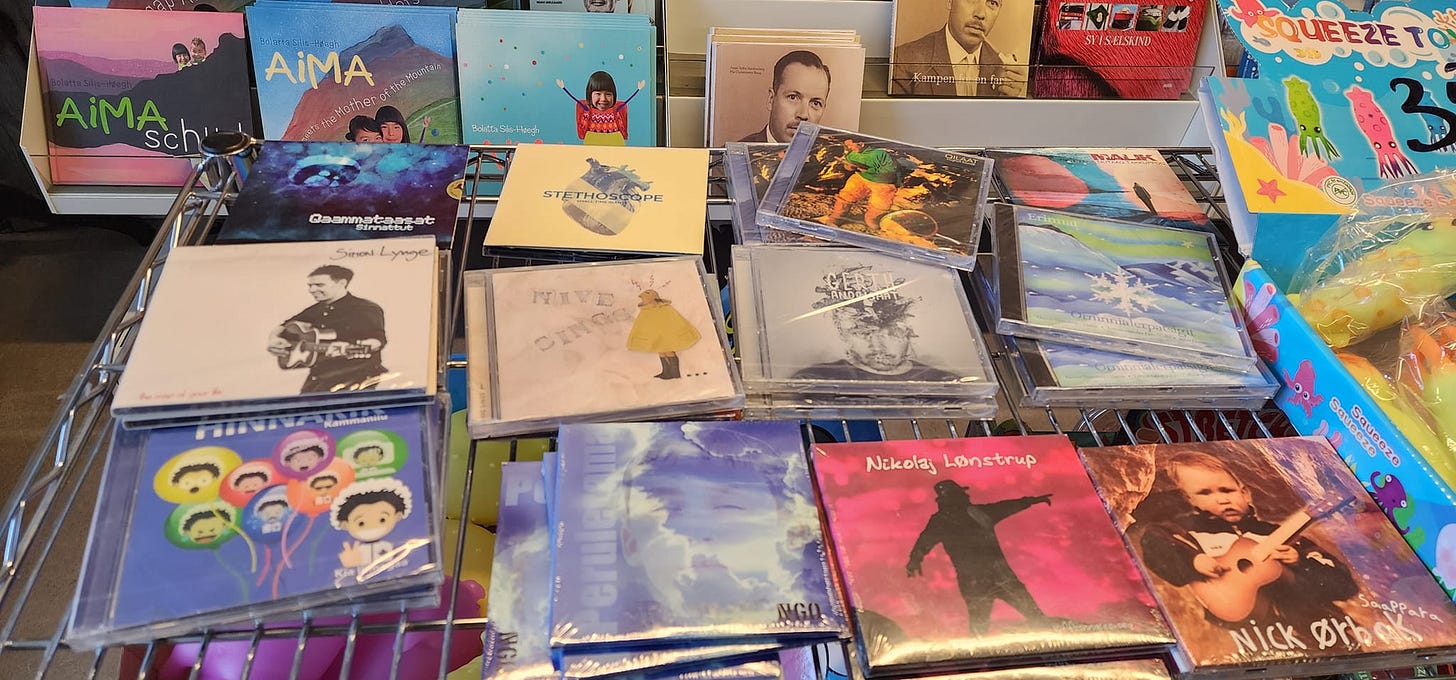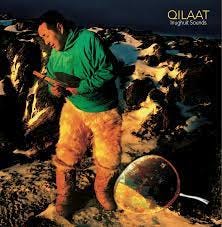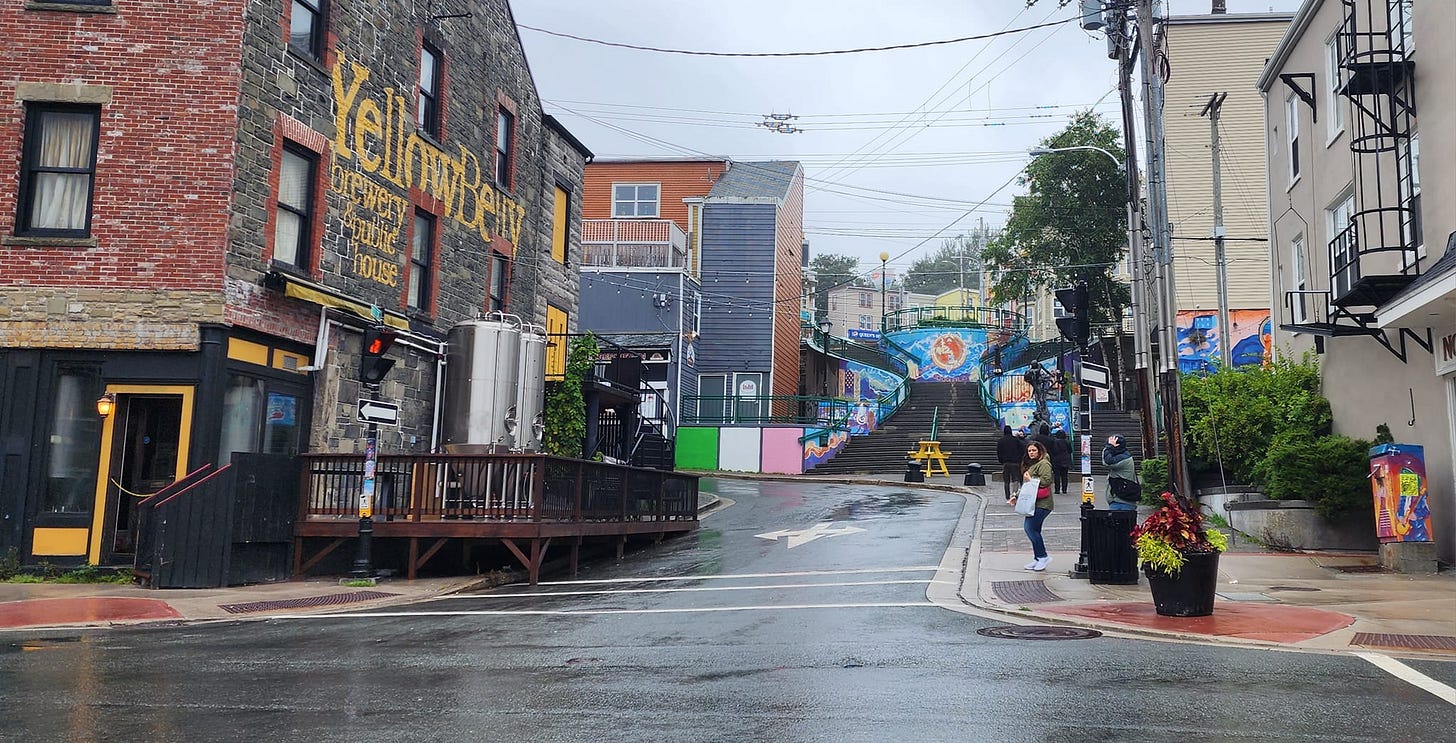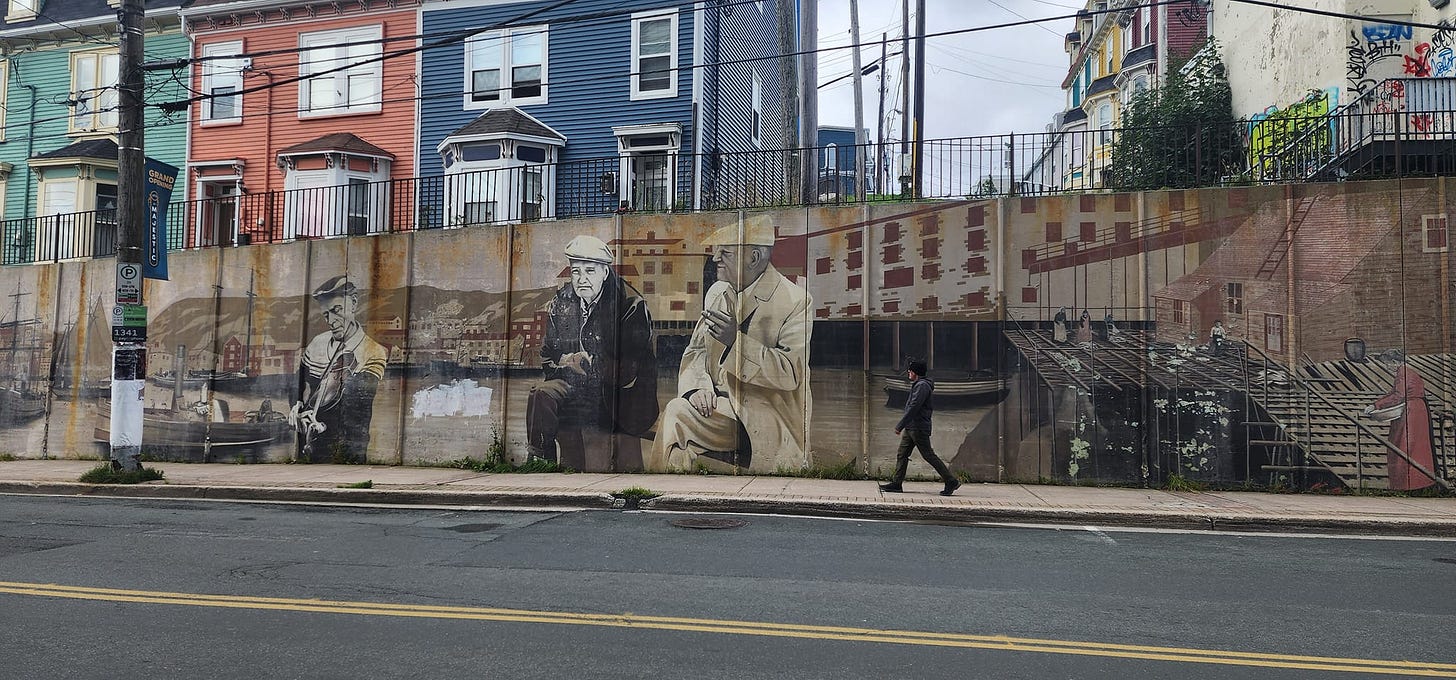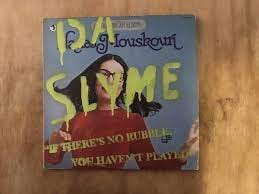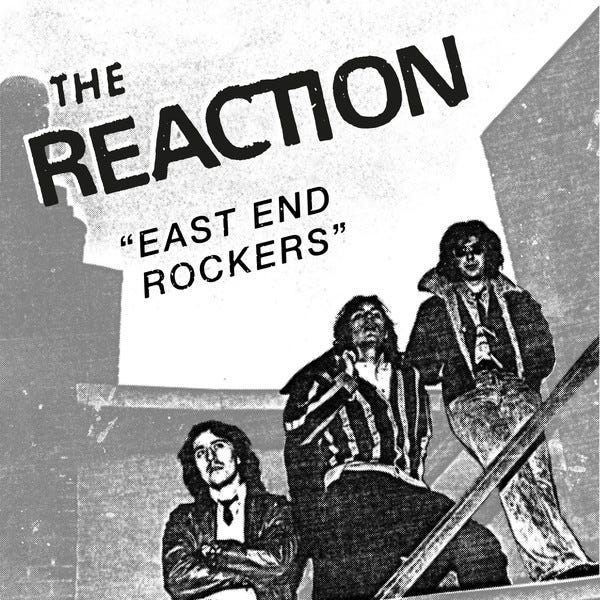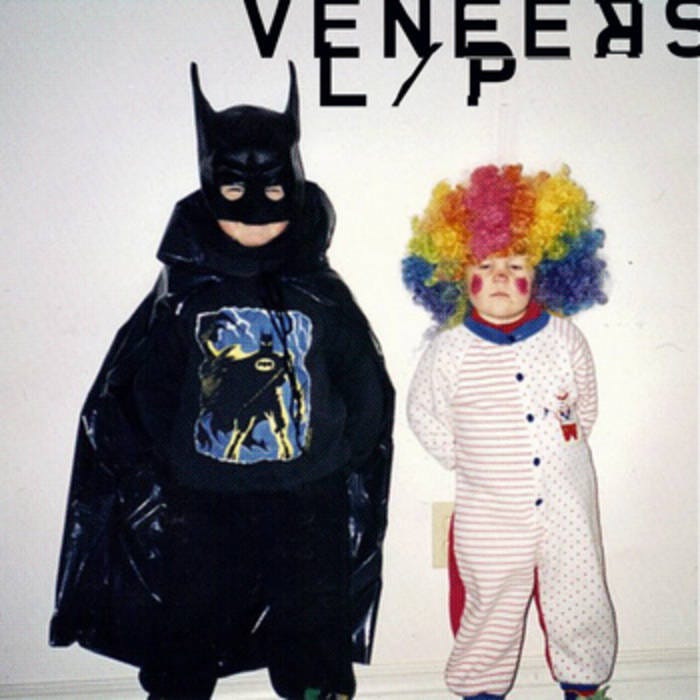What Do We Want? A Green Land and Newfound Records!
Adventures in Arctic Audio in Greenland and St. John's.

I dedicate this post to my partner in travel, adventure, and all things over the last quarter-century, the beautiful and talented Sherry “The Puffin" D., who has also provided the remarkable photos for this essay (inarguably the best thing about it). As I write this post we are celebrating our 24th wedding anniversary. Time and spirit do soar when one catches the perfect bird in hand.
The night before we flew to New Jersey to meet our ship and sail for the icy North Waters, I went to see Will Oldham, AKA Bonnie “Prince” Billy, perform at the Parish in Austin, Texas. I have seen Will play possibly more times than any other performer and probably in more geographical locations than any other as well: In multiple settings and incarnations throughout Texas (including inside a dramatic cave hidden in the hill country), in Chicago, and most recently in a field in Suffolk, England at the Mekonville Festival in 2017.
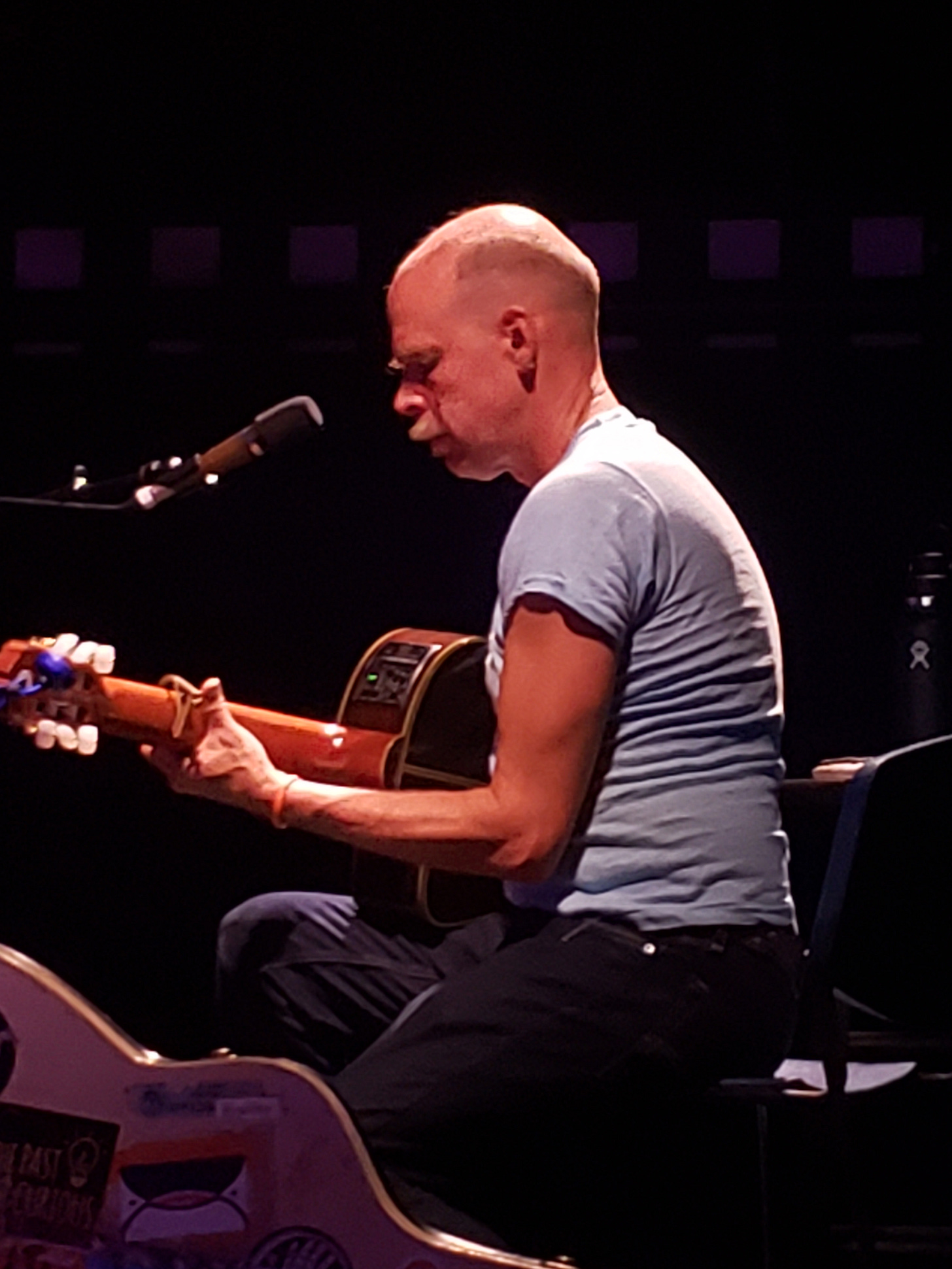
Oldham is always connected to the sea in my mind; not only because it is a theme he returns to over and over in his otherworldly music and myth-making lyrics but also because I first discovered his work as a sailor myself in the mid-1990s, through both his early Palace Brothers recordings and his startling portrayal of a mystical hard-shell Baptist child preacher prodigy/ West Virginia coal miner in John Sayles’ 1987 masterpiece Matewan (thanks to my great Virginia pal Jeff Hege for first introducing me to Will’s work). I’ve had the pleasure of interacting with the mysterious Mr. Oldham on a number of occasions and can boast that I once even went on a beer run for him in Denton, Texas. The warbling Appalachian songsmith is a true musical genius in the mold of Nick Cave, Leonard Cohen and Bob Dylan, effortlessly channeling weird old world ghosts. Oldham is influenced equally by both ancient musical traditions and folkways and the DIY ethos and experimentation of punk. At the Parish, he played a surprising number of my favorites of his many strange sea songs, including “Black Captain” and “West Palm Beach”, the latter an epic beachcomber romance which he dedicated to the recently deceased Jimmy Buffett in a rather offhanded manner. Among American singer-songwriters, no other artist I know of is so adept at uncannily evoking ancient misty mountaintops and strange seascapes; his songs are truly timeless and often seem to be drifting to shore from 200 years ago, while at other times they seem fragments floating on the ocean winds from Norse sagas some 1000 years back in time (Oldham even ventured to Iceland to record his stellar 2006 album The Letting Go, a deeply mystical and uncanny collaboration with the amazing Dawn McCarthy of Faun Fables who definitely shares his Gothic naturalist preoccupations and style).
Equally fortuitous and prophetic as far as my upcoming travels was Will’s opener Myriam Gendron, a Quebecois folksinger (in both French and English) from Montreal who matched Oldham’s cold and forlorn Nordic seascape sensibilities perfectly. Her 2021 album Ma Delire: Songs of Love, Lost and Found is simply one of the most beautiful, sad and haunting records I have had the pleasure to hear in many years, while Not So Deep as a Well, her 2015 album of Dorothy Parker poems set to music, is a very close runner-up. Myriam trades in sonic waves that, like Will Oldham’s, lap forlornly at the melancholy shores of the soul. The show was an astonishingly appropriate audio prelude and perfect soundscape to kick off our Arctic sea voyage to Greenland and Atlantic Canada.
Among the rare and exquisite pleasures of decadent late consumer capitalism, literally for my money, is the purchasing of new and exciting as yet unheard music in far-flung foreign lands. The thrill of discovering new worlds of sound is second only perhaps to the ecstasy of fresh foreign sights and similarly charges my imagination. Last week we returned from my first trip to Greenland and my second to Arctic Canada- Though sadly only seeing a bit of St. John’s, Newfoundland in the latter. In Greenland, we visited three settlements: The capital of Nuuk, Qaqortoq, and Nanortalik (more on these adventures here at Thee Vangarde soon). While we encountered a number of wonderful Inuit folksingers out of doors in these places (some of whose performances I filmed with permission), it was only in Nanortalik, the third and most remote of the three that we saw any recorded music for sale whatsoever. Still, ghostly music floated on the cold winds everywhere in Nanortalik. Hiking there amid the brightly colored but dilapidated shanties of the settlement, we encountered the woman pictured below sitting on the steps of her shack and strumming and singing for her own pleasure as half-starved hounds roamed about us seeking food. She interrupted her mournful song for a moment to hail Sherry with a loving “Hello Mama!”
We eventually found a batch of local CDs at a little ramshackle shop that doubled as a tourist bureau on the desolate main road of the settlement near the old white Lutheran church. Inside was the requisite enormous polar bear hide and all manner of souvenirs and indigenous art works and Sherry immediately sniffed out what appeared to be the most “traditional” music of the lot. We also wanted something a little more contemporary to see what the younger generation of Greenland was up to musically. There were two or three CD covers that had an urban, edgy feel to them so Sherry asked the girl who was running the joint- a cute and very elven Danish colonial with lots of metal in her face- for a suggestion.
The young woman recommended a CD by an act called Stethoscope, but after some consideration we decided instead to take a chance on an album called Anorisaat by an artist called Gerth. Based on the cover, this looked to be either post-rock of the Sigur Ros variety or then again maybe even something approaching Scandinavian black metal or Nordic punk, or perhaps even freak folk or hip-hop (When I toured nearby Iceland by car around this time last year, I had noticed it was fairly common for local musicians like Mugison to mash up such disparate genres into some new and fresh sonic stew).
Gerth’s soaring chamber pop turned out to be more in keeping with the former, very much in lineage to the solo work of Jonsi, Sigur Ros’ frontman. This similarity to Iceland’s spellbinding band of elf folk wasn’t too surprising. Almost a millennium before the Danish formally colonized Greenland in the 19th century, Norse Vikings from Iceland had established western and eastern settlements in Greenland, forming close ties between the two islands and fostering the sharing of a similar far-flung and chilly Nordic culture. Icelandic Viking farmsteads and church ruins are scattered throughout Greenland, while the Icelandic capital Reykjavik remains the closest thing to a metropolitan center in relative proximity to the remote outposts of Greenland (Polar bears from Greenland still occasionally make their way to Iceland on ice floes and surprise and terrify the locals there). All the lyrics on Gerth’s album are sung in Greenlandic and the artist, last name Lyberth, hails from the capital Nuuk and appears to be of shared First Nation and Danish descent. His profile on the Nordic Co-Operation website reads:
“Gerth (Gerth W. Lyberth) is an artist for whom the world has been waiting for a long time. His incomparable creativity is showcased in multiple popular videos on YouTube and Facebook. He writes and records all his own songs and videos. His debut album Anorisaat, which he recorded in his one-bedroom flat, features songs he worked on for up to 15 years. The genre is modern pop with electronic beats and sounds, distortion on the guitar and vocals of rare quality in Greenland. He sings upbeat songs and ballads, and it doesn’t get much more comforting than his telling vocals and melodic tunes. The album is richly colourful, and you can hear Gerth has spent time working on the songs.”
Despite what the above press release would lead one to believe, Gerth seems to have very little online presence, but here is one of his music videos as well as a short interview with him:
The more traditional selection we decided on was a 2019 collection called Qilaat: Inughuit Sounds (named for the traditional Greenlandic tribal frame drum, which is handheld like a fan and tapped. Apparently, ancient drum dancers engaged in a kind of prototype of Rap Wars, seeking to outdo one another in the summoning of spirits). The CD is a similar blend of indigenous Inuit styles with ethereal soundscapes but to me has a more authentic, dramatic and dreamlike feel than the postmodern Native stylings of Gerth. The album seems to be a collaboration between the “drum dancers” of the ancient Greenlandic Inuit and the more modernized Greenlanders of mixed Danish extraction. The overseers of the project are Christian and Frederik Elsner, who apparently are the creative forces behind Nanook, Greenland’s most popular band.
Interspersed with heavily produced guitar, vocal and electronic New Age dreamscapes that evoke icy Greenland while channeling the 1970s Werner Herzog soundtracks of Popol Vu are remarkable field recordings that recall the legendary collections of Alan Lomax and Harry Smith. There is a campfire tale in which a hunter imitates the sounds of a walrus, a narwhal and a polar bear as his dogs howl in the background. A folk tale about a woman with a polar bear for a baby is beautifully sung by drum dancer David Manumina and, according to the liner notes, was recorded before an audience of a thousand at Nuuk’s sports arena. Another of Manumina’s songs relates his grandfather’s reluctance to perform a sacred drum dance for some uninvited guests from Europe. The CD booklet contains remarkable photos of Greenland’s forbidding icescapes alongside personnel and production notes, as well as English translations of both song titles- “Snowstorm,” “Whales,” “Animal Sounds,” “Stormy,” “Perform the Drum Dance,” “Northern Lights,” etc.- and notes on the spoken word stories and some of the songs. It is quite a special collection and had me seeing the Aurora Borealis once again back home in Austin.
Following many days of sailing and our visits to New York City and the three settlements of Greenland (including a small boat excursion amid icebergs to explore the awesome and spectral Norse ruins of Hvalsey on a ghostly uninhabited island), we soon arrived in St. John’s, Newfoundland. After Greenland it was something of a culture shock to find ourselves back in an environment more closely resembling urban western civilization. This part of Canada likewise has its Viking lore, with the incredible ruins of Leif Erickson’s Vinland settlement at L'Anse aux Meadows still standing on the chilly northernmost tip of Newfoundland. St. John’s however is definitely Irishtown, and it was truly wonderful to be back in Celtic Canada, having explored the breadth of Nova Scotia many years previously. Roughly half the population of Newfoundland is of Irish descent, and the long and winding road around the peninsula of Witless Bay is still known as the Irish Loop. The capital of St. John’s, once a notoriously seedy port of call with an overwhelming number of taverns and brothels patronized by a motley and violent mix of European sailors, fishermen, knock-out artists and sneak-thieves (My kind of town!), still boasts more drinking establishments per capita than any other Atlantic Canadian province. The weather was cold and rainy as we made our way up the steep stairs through town for the 9:00AM mass at the Basilica of St. John the Baptist, a wondrous hilltop cathedral built by Irish hands in the 1800s. The service included transcendent organ and choral music cascading amid the awe-inspiring statuary, stained glass, and mosaic ceilings of the church’s lavish interior.
After the mass, we hustled through the pissing rain back to the ship to fortify our foul weather gear, then walked in the cold mist around Water and Duckworth streets and the tangle of pub-lined staircase alleys and side streets running between them. St. John’s is arguably the most Irish city in Canada. Everywhere you look there are elaborate murals and plaques commemorating the city’s Irish citizens and the contributions of the Benevolent Irish Society and the like. Almost every citizen we interacted with spoke with a thick Irish brogue. And of course, St. John’s is considered one of the Celtic music capitals of the world, and there is one Irish pub after another all throughout the downtown nooks and crannies. Sadly for us, while every pub in town- and again, there were countless numbers of them- seemed to offer live music nightly, there was nothing doing on this rainy weekday morning and afternoon despite the presence of our ship and the bustle of tourists it unloaded throughout the day. Another great misfortune for me was the overwhelming number of puffin shops that rivaled even that of the Irish pubs, every damned one of which Sherry of course had to meticulously explore (although I must admit there were a number of impressive Aukological finds). St. John’s also featured a lot of outstanding street art around every corner, much of it related to seafaring and the Irish immigrant experience. It’s a remarkably beautiful little city with a lot of culture and class.
We soon found our way to Fred’s Records, Newfoundland’s finest record store, on Duckworth Street. As is the way with such places, the store was completely empty save for a silent clerk hiding behind the register who would not deign to speak unless spoken to. I knew the routine so I quietly browsed for a few minutes before approaching him and politely inquiring if he had any suggestions as far as local punk, metal or experimental music from Newfoundland. He came alive then and really went to work and I had a pretty incredible shopping experience with him.
The first record he threw my way appeared to be a kind of artisan bootleg LP by Newfoundland’s legendary first punk band Da Slyme, titled “If There’s No Rumble, You Haven’t Played: Collected Recordings 1977-89.” The clerk informed me that the group was more in lineage with the avant-garde weirdness of Captain Beefheart than with British rock acts like the Sex Pistols. The packaging of the album was certainly intriguing enough. The cover was a blank white sleeve with what appeared to be a blue Xeroxed gig flyer glued to it featuring a lo-res mimeographed photo of the scruffy group boozing in an alleyway alongside a listing of their silly “punk” pseudonyms (Pig Filthy, Snotty Slime, Stig Stilletto, etc.) and the various instruments played (including “Intoxification”, “Nostril”, “Tissue” and “Pantyhose”). Below this were fake review blurbs by the likes of “CirKus Magazine” and “Fester Hangs” and in the bottom right corner was the official red rubber stamp of Celluloid Lunch Records. Turning the record over I discovered what appeared to be an old punk fanzine slipped into the plastic protector sleeve which turned out to be a history of the band comprised of new essays by its members along with old gig flyers, photos, and related ephemera. Press clippings from the local papers furthered the historical record, and it appeared that the mainstream journalists of St. John’s were rather bemused and amused by Newfoundland’s first punk act and that the writers seemed to have a grudging respect for the sheer nerve of Da Slyme’s freakshow musical theater. Inside the cover itself was a large foldout collage poster with more black & white images of the strange gang of rowdy noise-art provocateurs. There was also a download card included.
The many images of the band on the poster and in the hefty ‘zine mag show the members to be a rotating gang of tough alcoholic seaside roughnecks who look as though they just stepped off a whaling ship after several months and might easily be hired to take tourists out to club baby seals. Only two of the these lumberjacks look remotely “punk rock,” one faintly resembles a scruffy Shane MacGowan in sunshades perched drunkenly at the mic while the other is a spastic-looking bespectacled David Byrne type. Actually, the latter Slyme unit resembles the dangerous and demented Texas punk legend Bobby Soxx far more than Byrne; a point to which I will return later in an extended digression.
The others members- and there appears to be a whole army of them although their individual names/aliases never accompany the wealth of photos- have long and unkempt but decidedly unhip hair and even sport bushy beards and very 70s moustaches. One denim-clad beer-bellied beardo regularly sports a cowboy hat and looks more like Blaze Foley than Sid Vicious, although I guess that’s pretty punk in its own right. It could also be argued that some of the other guys have a certain degenerate sleazoid “1970” Ashton Brothers/ Stooges quality, or perhaps a sort of Minutemen or Husker Du denim-and-plaid workingman’s vibe. They certainly might pass as members of Crazy Horse when Neil Young was at his most unwashed and grubbiest (some things never change). Based on other included photos, some of the boys in the band also wore strange masks at times, lending them the air of professional wrestlers much like New York’s The Dictators; in fact a flyer for one of Da Slyme’s gigs similarly announces their concert as a grapplers’ “grudge match” with another band called The Riot. A toilet on stage graffitied with “Da Slyme” provides a backdrop for their stage shows, while plastic baby dolls and Christmas yard décor reindeers are wielded as props. There were apparently saxophones, harmonicas, and even woodwind instruments involved in the performances at times. Rather than taking punk seriously in the least, Da Slyme was taking the piss out of punk. This is punk rock as high-concept satirical theater, as parodic performance art happening, as damaged and demented street cabaret.
According to the history laid out in the 32-page ‘zine booklet, Touloose and Da Slyme, as the collective first called itself, formed near the end of 1977, and was composed of a rotating roster of collaborators (referred to as “units” rather than band members in their press materials) working at the student radio station at St. John’s Memorial University, where they gained access to the new wave of records coming out of England and New York. Allegedly, all hell broke loose at their first gig at the university in 1978; patrons were provoked, fists connected with faces, bottles broke, and emergency rooms were visited. In the band’s flyers and other promotional materials, Da Slyme cultivated an occult mystique, drawing on the Book of Revelations, Tarot cards, the American clairvoyant Edgar Cayce and the Renaissance-era doomsday prophet Nostradamus (or, “Edgar Casey” and “Nostraldamnus”) alongside the band’s own cryptic prophecies regarding things like “the Evil of the eons…soon to be unleashed in the world…The land, sea and ice are doomed…” They proclaimed a connection “between Newfoundland and the Third Secret of Fatima” and declared that “Armeggedeon” would “soon manifest itself in St. John’s, Newfoundland.” Such arcane mysticism was just another of the group’s pranks, one exactly in the spirit of Texas’ own punky culture-jamming “religion,” The Church of the SubGenius, which had become a staple of the post-hippy/pre-punk counterculture a few years before. There are also several references to the tyranny of US President Ronald Reagan and George Orwell’s classic dystopian novel 1984 among Da Slyme’s promotional ephemera.
Da Slyme self-released their debut record on the band’s own Loo Enterprises label in 1980, a double album collection featuring one disc of studio recordings and a second platter of live chaos recorded at local clubs like TSC Cafe and Middle Earth. Due to both the non-existence and non-interest of independent labels in Newfoundland, the band’s DIY approach to getting their recordings out included packaging the vinyl in other artists’ record covers, on which they spray painted “Da Slyme” (This 1980 debut album is actually far superior to the new collection I purchased from Fred’s and can easily be found streaming on Youtube). No further release followed, only a few gigs scattered throughout the years. Then, surprisingly enough and due to the pseudo-urban folklore that continued to surround their exploits, the gang of art thugs released a live album of all-new material almost two decades later in 1999.
On the new Celluloid Lunch collection I picked up, many of the songs are culled from live performances and are of abysmal audio quality which seems to be the point of Da Slyme. The tracks are also all over the map both sonically and lyrically but most tend toward the goofy brain-damaged teen silliness of the Ramones or Dickies with the stupid gross-out crudisms of early GG Allin or the Mentors thrown in for bad measure (“Piss-Eyed Sleazoid,” “Defecation on the Nation,” “I Wanna Pick My Nose,” “Ain’t Got No IQ,” “Squeeze my Blackheads,” “Lick Linoleum,” “Eat My Shorts if You Love Me,” etc.). Other songs, like “My Mind is Shot,” “Urban Renewal,” Right-Wing Power,” and “Running from the Weapons of War” seem to affirm the group’s Marxist political leanings, perhaps a bid at serious punk rock street cred, as does “Violence-Anarchy-Baby-Mother-Daddio-Dig,” a rollicking screed against the record industry’s cooption of punk’s alternative culture. Other songs are actually rather clever, including “Fail-Safe Video Games” which addresses the use of the titular juvenile pastime to train children for real nuclear warfare (I don’t believe many people were talking about this back in the early 80s). “The 1000-Year Scam and the $12 Sneakers” lyrically and vocally comes off like a damaged Watergate-era protest song by Bob Dylan. There are flirtations with the sounds of the New York scene, including the funkier aspects of Talking Heads and a couple of sax-driven forays into Contortions-style no-wave punk jazz. Despite the declarations of songs like “No Talent” and “One Chord Punk Rock Song,” Da Slyme was not simply a talentless joke band devoid of any musical skills. Some of the songs are truly great and their second drummer Dead Beat is particularly adept and on point throughout his tracks. In addition to the songs, there are quite a few incendiary stage introductions by the band and its fellow travelers on the record, and also some promotional ads from the local St. John’s radio station which several of the band’s Units worked for and/or volunteered at that would be at home with the radio spots featured on side four of Black Flag’s Everything Went Black collection.
Taking all the visual documentation and music of the record together, Da Slyme immediately called to my mind the earliest days of the punk scene in Dallas, Texas. I was too young to have been in on that first wave of Big D punk but when I came onto the scene in the mid-80s, a group called Stickmen with Rayguns were still playing around town- fronted by the offensive, terrifying and probably psychopathic Bobby Soxx, who rather incongruously looked like a dorky inbred hillbilly gas station attendant, Deliverance by way of Elvis Costello. Unlike Da Slyme, the Stickmen were not their city’s first punk band. That honor would probably go to the Nervebreakers, who formed in 1973 and opened for the Sex Pistols at the Longhorn Ballroom five years later and also played gigs with Johnny Thunders, the Ramones and other premiere first-wave punk acts. Despite their much later arrival around 1982, Stickmen with Rayguns are today considered among the city’s legendary first-wave punk acts and their unholy noise and shambolic stage antics certainly sent shock waves through the local music scene throughout the 1980s (in contrast to the Nervebreakers, who were much more of a straightforward Texas rock & roll band who adapted their sound to punk when it came along). To borrow a quote from John Sayles about the cinema of John Cassavetes, a Stickmen with Rayguns gig was never a safe place to be. It was however, certainly a night at the theater.
Like Bobby Soxx and company, the sheer redneckedness of Da Slyme and their aggressively over-the-top approach to music, image, and performance seems very much in keeping with how nascent punk scenes tended to develop in provincial backwaters in the late 1970s, including Dallas. This was second-hand first-wave punk if you will. Often the music coming out of London and New York was simply misunderstood in less “sophisticated” cities and you can almost envision acts like Stickmen with Rayguns and Da Slyme checking off a list of punk criteria as they got up and running: Play loud. Don’t play well. Be rude, offensive, and aggressive and swear a lot. Be tasteless. Be terrifying. And be a bit funny and very satirical. Be drunk or on drugs. Destroy the pubs and otherwise engage in acts of violence and chaos. Check. And although Bobby Soxx would often dress in what passed for punk fashion, one thing that most of these redneck punks would not go along with was donning any kind of punk rock couture or uniform, other than something along the lines of a theatrical Halloween costume or some other campy accoutrements on occasion.
“Punk Rock” was always bound up with wider cultural transformations beyond music, and fashion was certainly as integral to the mystique of the new bands and their followers erupting out of New York and London in the 1970s as any new sounds that were being created. How could one be identified as, or self-identify as, a “Punk Rocker” except by donning elements of an agreed upon tribal uniform inspired by the likes of the Pistols, the Clash, the Ramones, Richard Hell, etc. ? In their everyday blue collar clothes and unassuming square hair styles, backwater second-hand punks insisted on remaining true to the yokels that they were- Restless natives from Texas or Newfoundland or whatever cultural wilderness they were born into (As far as the first wave LA punk scene, most of those guys and gals also wore their street clothes rather than garb that explicitly signaled or screamed “punk rocker”; however that crowd’s style tended toward either that of the related surf and skateboard subculture which was very much en vogue [Black Flag, Circle Jerks] or the hip Hollywoodbilly grease monkey look [X, Flesh Eaters, Fear] rather than anything approaching backwoods trailer trash. Of course there were exceptions like the Germs and Social Distortion who clearly modeled their look on what they knew of the scenes in New York and London). This is not to say one can’t be a punk without punk couture (a theory that is absolutely untenable), but rather that fashion was as integral to the original movement as the music itself and that looking like a normal square person sacrifices an intrinsic element of what 1977 era punk was all about.
Like so many artistic movements, punk was about transformation and transcendence; something to believe in amid the chaos and uncertainty of existence and the stultifying constraints of one’s environment. For many, myself included, it was something like a religious calling. One gets the feeling that guys like Stickman Bobby Soxx and Slyme unit Stig Stilletto were actors searching for a part when they stumbled upon the foreign and exotic sounds and no-holds-barred potentialities of punk. They interpreted and translated their own version of the emerging alien genre in order to act out their most subversive fantasies and express their true authentic and demented selves in the staid, repressive communities they called home but felt they didn’t belong in. They were perhaps blank canvases who might have never had any serious interest in music or art at all had punk not arrived like an atom bomb and blown open new doors of possibility, allowing them a freedom of unfettered and profane expression they had never known before. Which is ultimately why a band like Da Slyme is so ultimately punk. They were their own authentic selves on stage and on record; a band from a remote fishing village backwater who took what they understood of the emerging punk music genre and adapted it to their hometown environment. Like Stickmen with Rayguns in Dallas, Da Slyme seem to have used punk to create a long-term avant-garde performance art project that was free of artifice and sought no one’s approval (quite the contrary), turning the music scene of their boondock town on its head while bizarrely celebrating their roots there in the process.
Although Da Slyme only played around 30 gigs over two decades, they clearly grasped what becomes a legend most in and around St. John’s. They played their last, if not final, gig in 1999, coinciding with the release of their second album some 22 years after their formation and over a decade since they had last performed live. They signed off that night by telling their fans that they would now be taking a break but would see them in 20 (expletive) years. Today their first (double) album from 1980 commands the highest of prices from punk completist collectors; two copies are currently available on the Discogs site for a whopping $1,500 each. This for a record that originally sold for “an evil $6.66 with tax” according to a 1980 edition of The Newfoundland Herald. Be careful when you search for information on this band online because you’ll find that the internet is thick wit’ Da Slyme.
A four-song 7” single titled “East End Rockers” by a group called The Reaction was the first record to grab my interest at Fred’s, even before I had asked the clerk for some guidance. The black & white photos on the front and back cover clearly revealed these natty longhairs to be a pub rock/punk band circa 1977, and by the redneck fashion standards of Da Slyme, they might even be considered glam-rockers. The tracks on the single were recorded in 1979 and 1980 at Echo Recording Studios in St. John’s, Newfoundland. Inside the cover was a 12-page booklet tracing the history of The Reaction in text and photos. Shepherded by Da Slyme as a sort of baby brother band with the two groups sometimes sharing personnel, The Reaction formed in late 1978, taking their name from a lyric by The Jam and playing covers by the Sex Pistols, Eddie and the Hot Rods, Ian Dury & the Blockheads, Generation X, the Rolling Stones and The Who. The band was soon penning and performing garagey power pop originals like “Waiting in Line” and “Trials in Error” as they toured their way across Newfoundland and into Nova Scotia. They played their final gig in the early summer of 1981. Unlike the experimental and theatrical primitivism of their buddies Da Slyme, The Reaction’s style- their tunes as well as personal appearance- are very much in the tradition of British pre-punk pub rockers like Dr. Feelgood and The 101ers, and they come across as a straightforward rock band to some degree. That said, the four high-energy tracks on the Supreme Echo rerelease single contain distinct echoes of classic British punk acts like The Adverts, Buzzcocks, Slaughter & the Dogs, and The Clash as well as Northern Ireland’s Stiff Little Fingers. Their songs “The Kid’s Arrived” and “Get the Rods Out” are so catchy and cool they might should be considered pop-punk essentials, which is something Da Slyme could never boast of.
I passed on a Reaction full-length CD in favor of the single and also said no to an LP by a local metal band because the cover art looked a bit cheesy and the clerk said that the record was pretty straightforward metal with no sort of local flavor. I also considered buying a book on Newfoundland’s alternative music scene (Let It All Fall: Underground Music and the Culture of Rebellion in Newfoundland, 1977-95 by Mike Heffernan) but held off on that as well; might look for it on Ebay if my interest holds. The clerk then announced that he had a secret stash of records upstairs with some really great and rare stuff. I told him not to go to any trouble but he insisted on bringing a few things down for me to look at. He came back to the shop with a stack of 7” singles and told me I could have my pick for $3 CA each- about $2 US. He had already told me a bit about Veneers, a band who started out in St. John’s but soon moved on to the supposedly bigger and better scenes in Toronto and Montreal, and he offered up a 33 RPM Split 7” featuring the group released by a local label called Anteduvia. The Veneers side has two songs, “Arrows of Fire & Time” and “Pity, Pity Too Late.” Veneers play loud, spastic screamo postpunk, with ragged jangly guitars, driving bass and drums, and weird angular avant-jazz leanings accompanied by well-yelled lyrics of existential angst. Wonderful. The group apparently achieved some level of notoriety in the 2010s but are presumably now defunct (their Facebook page hasn’t been updated since 2014) .The other side of the record features a similarly experimental and interesting group called L/P hailing from Truro, Nova Scotia. L/P artfully blasts out syncopated but melodic metallic punk with “Rags,” Minimal1” and “Age is.” The single is undated (released in 2011 according to Veneers’ Bandcamp page) and features a color sleeve with an intriguing image of costumed children and a cassette-sized mimeographed lyric sheet with artwork inside.
I am something of a medievalist you might say and am an easy mark for anything to do with the olde wyrde Europe and the intersection of Christianity and paganism, so the clerk’s offering of a 7” 33RPM single by a Newfoundland act called Crusades was a quick sale. The cover features a crude drawing of a forlorn battle banner blowing in the winds below a crumbling hillside castle and a skull impaled on a fence spike below, while the back face features both a guillotine and a molotov cocktail. Meanwhile the labels on the vinyl itself feature swords, shields and more skulls on one side and a grisly scene of inverted crucifixions on the other. The full sized mimeographed lyric sheet inside is white on black and emblazoned with with warlike torches, and the whole visual effect is one of early Scandinavian Black Metal; however the brutal music of Crusades is all slow tempo hardcore punk. A bit derivative and unoriginal perhaps but effective nonetheless. According to the Discogs website this was the band’s only release, the first and last record put out by their own Building Block Records in 2007. Interestingly, a remarkably similar band called Crusades currently hails from Ontario, Canada and may or may not contain some of the same DNA as these earlier battle-weary hardcore warriors. But the Crusades of Newfoundland 2007 seem to have faded into the mist and gloom of bloody history by the time of this writing.
The fourth 7” I said “Sold!” to was a 3-song 33RPM single by a straightedge punk band from St. John’s called Regiment, undated but apparently released in 2008 on the Anteduvia label (my copy is numbered 69/100). The black & white cover features a gruesome cartoonish image reminiscent of the SST Records cover art of Raymond Pettibon and there is indeed a Rollins-era Black Flag element to the three songs as well as the usual Minor Threat influence of straightedge punk adherents. The tunes- “Sanctuary,” “Nine of Swords” and “Salvation"- are each pretty solid. The cover folds out and inside is a lyric sheet, production notes, and some headshots of the band, who appear to have been sweet cherub-faced high schoolers back in 2008. Regiment includes their mission statement at the bottom of the liner notes: “Regiment. Support a Straightedge Lifestyle. Fuck you.” You go, boys! I was unable to discover anything about this scrappy young group during a brief search of the internet but here is the single on Bandcamp:
Since I was in one of the Celtic music capitals of the world and have a deep love for seafaring songs and Irish balladry, I next I asked the clerk for some personal recommendations for Newfoundland Folk records. His favorite among the more contemporary practitioners of the form was a band called Rum Ragged. He suggested two CDs by them and I went with 2018’s The Hard Times based solely on its cover image featuring a pair of Great Auks. Released by Newfoundland Labrador MusicNL, it’s a solid trad collection of mostly gentle romantic ballads, sea shanties, jigs & reels, and spoken word storytelling, most of which are old traditionals and many specific to Newfoundland. It also boasts one of the best lines I’ve heard in some time: “We’re dirt poor, tatters and rags/ We’re dirt poor, but we’re not dirt bags.” Solid seaside workingman’s folk.
As far as the older school of Newfoundland folkies, the clerk raved about an album called Towards the Sunset by Pat and Joe Byrne with Baxter Wareham, originally released on vinyl in 1983 and recently rereleased on CD on the St. John’s Singsong label. He claimed it contained some of the most authentic and therefore dark and depressing folk music he had ever heard, with many of the songs dealing with the traumatic displacement of Newfoundlanders due to Resettlement policies and the ruthless government policing of fisheries beginning in the 1950s. He proclaimed it not just his favorite folk album but one of his very favorite albums of all time. I said, “Yes, please!” This was the album I was most excited to listen to but there was a problem. I will let my subsequent email to Fred’s Records regarding this situation do the ‘splaining:
“Hello, I was in your store last week and bought a lot of records and CDs which I have been very much enjoying. However there is a problem with one of the CDs. The clerk at Fred's highly recommended a Newfoundland folk CD called "Towards the Sunset" by Pat & Joe Byrne w/ Baxter Wareham. I was surprised when I played it back at home as it was nothing remotely like the dark seafaring folk music the clerk described and was instead more in the vein of 1970s country & western. Then I noticed thst none of the song titles related to the actual songs at all. So I found the Byrne album I thought I had bought streaming on YouTube and lo and behold it is not remotely what is on my CD. The CD itself even has the label for the Byrne album but again is not the correct music at all. This must have been a mixup when the CDs were pressed as the CD was brand new and cellophaned. I am now back home in Austin, Texas and wondering if there might be a way to make this right. Attached are some images for you. On another note, I previously sent you guys a message on Facebook re: a blog entry I am working on about your great store and the awesome clerk who helped me. I have yet to receive a response. Hope to hear from you soon.”
In the meantime, I ordered the original vinyl release of Towards the Sunset from Discogs and also located and streamed the album in its entirety on Youtube. The clerk had not lied; it is quite special I think. Check it here:
As far as the misprinted CD I bought, it continued to grow on me so I decided to keep it and not bother Fred’s any further with a return, replacement or refund. The singer and the songs owe an obvious debt to Toronto’s late great Gordon Lightfoot and they also channel Leonard Cohen at his most countrified. Strangely, even my computer misread the album and song titles as those of the Byrne CD I thought I had bought. I did a number of google searches by typing in some of the lyrics I was hearing and I also sent some mp3s to the folks at Fred’s to see if they could place the artist. But as of now the singer-songwriter remains an elusive Atlantic Canadian country folk enigma.
After leaving the sonic utopia of Fred’s, we stopped by a convenience store up the hill which prospective customers had to be buzzed into; apparently dreamy St. John’s has its own problems with crime. Then we went for delicious fresh fish & chips and Iceberg beer at the legendary Duke of Duckworth pub followed by another pint at the Celtic Hearth on Water Street before setting sail back through the Straits of White Bay North, homeward bound after two weeks in the coal black seas of the Arctic North. My parents had spent the day touring St. John’s and the surrounding environs in a hired car, taking in such beautiful sites as Signal Hill and Quidi Vidi Lake. Their driver had an interesting bit of music history to tell. So, in Atlantic Canada there is both a St. John’s, Newfoundland and a Saint John, New Brunswick. This obviously causes no little confusion for travel researchers. Anyway, the driver said that 15 or 20 years ago, David Bowie was scheduled to play a show in St. John’s, Newfoundland but all the equipment for the show had been mistakenly routed to Saint John, New Brunswick, some 1700 km south on the mainland. Apparently, rather than cancel the St. John’s concert as most performers of his interstellar prestige would have done, Bowie instead declared that the show must go on and did a very stripped down and intimate version of his elaborate stage show for the Newfoundland fans that night. God bless David Bowie; the world hasn’t been the same since he left us and never will be, but take heart, earthlings: There’s a Starman waiting in the sky.
Upon arriving back home, I was delighted to see I had received a new record in the mail in my absence. Estranged is the wonderful 2018 LP by Dusty Stray, the Amsterdam-based musical project of Jonathan Brown, a beautiful and effortlessly talented man I have been honored to call a dear friend since our high school days together. He was the first great artist I ever met and remains relentless in keeping the faith in all good things. There is always a bit of thee olde northern chilliness to Jonathan’s haunting and whimsical folkwork which is one of the many reasons I love it. Have a listen and a look below and seek him out on the interweb.
More about our Greenland expedition soon. For now, I leave you with the late, great Lou Reed and one of his own seafaring masterpieces (there are more than you might think), a song which I sang to myself on a loop throughout our entire voyage, particularly during a two-day spell of a mysterious debilitating illness while out at sea. Of course, the song is really about the unnavigable psychic seas of life and death, of magic and loss, rather than any literal ocean but that is a tale for another day. Until next time, Fair Winds and Following Seas.
I have a favor to ask of you, Dear Reader. If you find these topics of interest, please subscribe to Thee Bat City Vangarde’s newsletter below and share this post with like-minded freaks friends. You may also contribute with a small donation should the spirit move you. Any and all support is greatly appreciated as it allows me to remain underemployed the freedom to write. I also hope to feature the work of other writers on this platform in the near future, so please contact me if interested in such a prospect. Thanks for reading!





